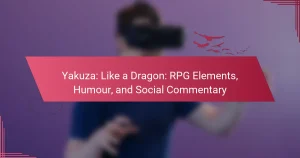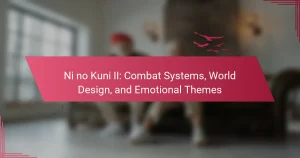Hollow Knight captivates players with its intricate exploration, engaging combat mechanics, and stunning artistic design. Players navigate a vast interconnected world, facing diverse enemies while customizing their abilities. The hand-drawn visuals create an immersive atmosphere, enriching the gameplay experience. This article delves into the key aspects that make Hollow Knight a memorable title in the gaming landscape.
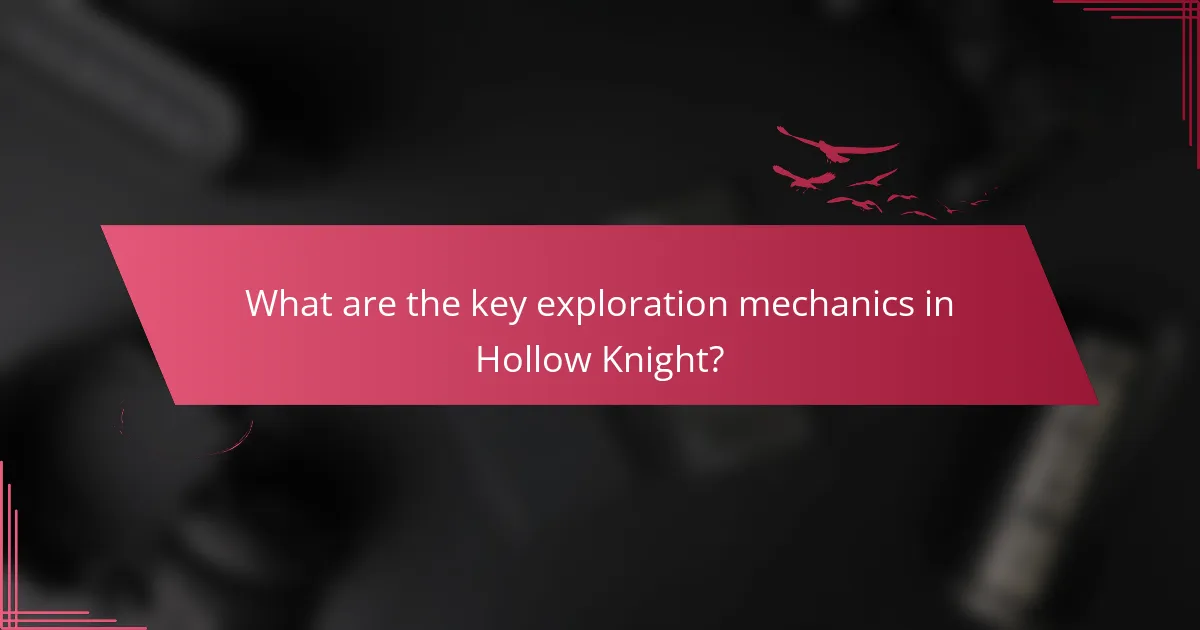
What are the key exploration mechanics in Hollow Knight?
Hollow Knight features key exploration mechanics that enhance gameplay and immersion. Players navigate a vast interconnected world, utilizing abilities like wall jumping and dashing to access new areas. Environmental storytelling and hidden secrets encourage thorough exploration. The map system, combined with waypoints, aids in tracking progress and navigating the intricate landscape. Unique attributes include the ability to discover lore through interactions and collectibles, enriching the overall experience.
How does map design influence player navigation?
Map design significantly influences player navigation by shaping the exploration experience and guiding movement. In “Hollow Knight,” the interconnected world design encourages players to discover hidden areas and shortcuts. The layout of maps, including landmarks and obstacles, directs attention and enhances immersion. Unique attributes, like the presence of distinct biomes, further enrich navigation, allowing players to form mental maps of the environment. As a result, thoughtful map design fosters a sense of achievement and discovery, vital for player engagement.
Which areas offer the most rewarding exploration experiences?
Hollow Knight offers rewarding exploration experiences primarily in areas like Hallownest’s Forgotten Crossroads, the intricate City of Tears, and the challenging Deepnest. Each area features unique mechanics, secrets, and atmospheric design that enhance the adventure. The Forgotten Crossroads serves as a central hub, allowing players to access various paths. The City of Tears immerses players in a melancholic environment filled with lore and challenging enemies. Deepnest presents a rare blend of tension and discovery, showcasing the game’s artistic design and combat mechanics through its dark, labyrinthine structure.
What role do shortcuts play in the game’s exploration?
Shortcuts significantly enhance exploration in Hollow Knight by facilitating quicker navigation and access to hidden areas. They enable players to revisit previously explored zones efficiently, enriching the overall experience. The game’s design incorporates shortcuts as a unique attribute, rewarding players for their exploration efforts. This mechanic encourages experimentation with the environment, fostering a sense of discovery and mastery.
How does the use of charms enhance exploration?
Charms significantly enhance exploration in Hollow Knight by providing unique abilities and bonuses. Players can customize their playstyle, allowing for diverse traversal options and strategies. For example, the “Gathering Swarm” charm attracts nearby Geo, facilitating resource collection during exploration. This customization encourages players to adapt their approach based on the environment and challenges they face. Additionally, charms can influence combat mechanics, making encounters more dynamic and engaging. Overall, the charm system enriches the exploration experience, promoting experimentation and strategic decision-making.
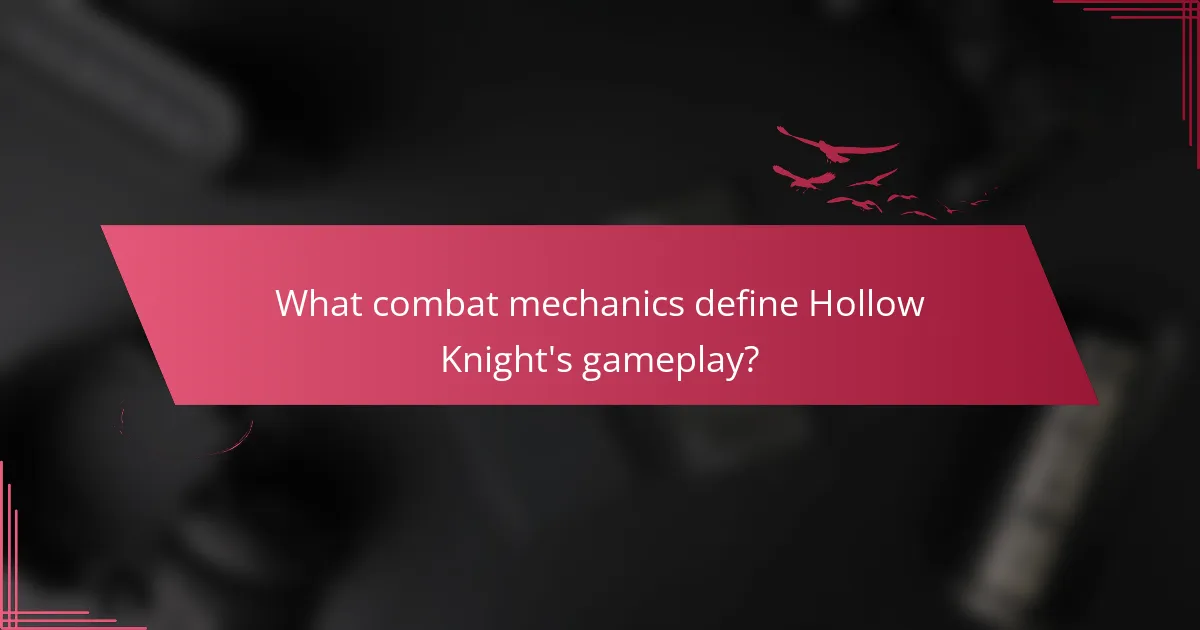
What combat mechanics define Hollow Knight’s gameplay?
Hollow Knight’s gameplay is defined by fluid combat mechanics, diverse abilities, and strategic enemy encounters. Players utilize a combination of melee attacks, spells, and dodging techniques to navigate challenging battles. The game features unique attributes such as charm customization, enhancing combat styles and strategies. Exploration intertwines with combat, as players discover new abilities that alter their approach to fights. Enemy design varies significantly, requiring players to adapt their tactics in real-time, which enriches the overall experience.
How do different weapons affect combat strategy?
Different weapons significantly influence combat strategy in Hollow Knight. Each weapon type offers unique attributes that affect attack patterns, range, and damage output, shaping player tactics.
Swords provide balanced speed and damage, favouring close-range encounters. Nail arts enhance attack power but require precise timing. Ranged weapons, like spells, allow for tactical distance management, creating opportunities for evasive maneuvers. Heavy weapons deliver high damage but slow down mobility, necessitating careful positioning.
Players must adapt their strategies based on weapon selection, enemy types, and environmental factors. Understanding these dynamics enhances exploration and combat efficiency, ultimately impacting overall gameplay success.
What is the significance of the parry system in battles?
The parry system in Hollow Knight is crucial for mastering combat. It allows players to deflect enemy attacks, creating opportunities for counterattacks. This mechanic enhances strategic depth, encouraging precise timing and positioning. Successful parries can lead to advantageous situations, such as stunning enemies or creating openings for critical hits. Overall, the parry system significantly elevates the combat experience by rewarding skillful play and promoting engagement in battles.
How do enemy types challenge player skills?
Enemy types in Hollow Knight challenge player skills by introducing varied combat mechanics and requiring strategic adaptability. Each enemy possesses unique attack patterns and abilities, pushing players to refine their timing and movement. For instance, fast-moving foes test reflexes, while larger enemies demand careful positioning and resource management. This diversity fosters a deeper understanding of the game’s combat system and enhances overall player engagement. As players encounter more complex enemy types, they develop critical skills that are essential for progressing through the game’s intricate environments.
What impact do boss fights have on combat mechanics?
Boss fights significantly enhance combat mechanics by introducing unique challenges and requiring players to adapt their strategies. They often feature distinct attack patterns and mechanics that differ from standard enemies, promoting skill development. Additionally, successful navigation of boss encounters can lead to valuable rewards, reinforcing exploration and progression. The complexity of these fights encourages players to experiment with various abilities and weapons, deepening their engagement with the combat system.
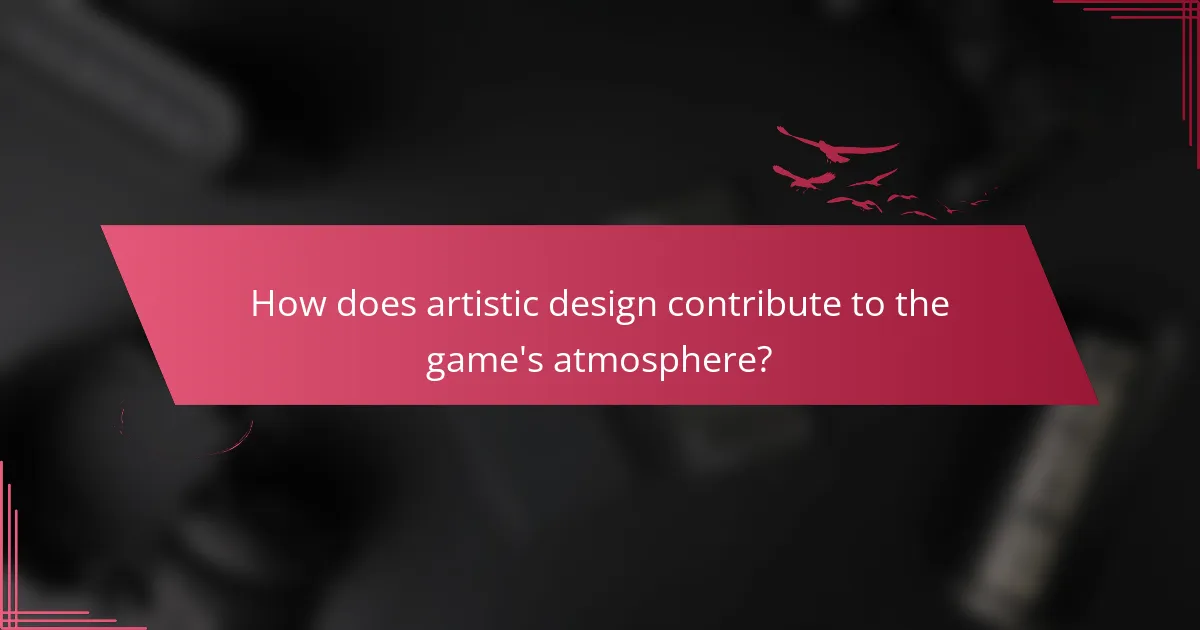
How does artistic design contribute to the game’s atmosphere?
Artistic design significantly enhances the atmosphere of Hollow Knight by creating an immersive world. The hand-drawn visuals and intricate environments evoke emotions, guiding players through the game’s narrative. Unique attributes like the contrasting biomes, from the eerie Forgotten Crossroads to the vibrant Greenpath, contribute to a rich exploration experience. The use of color, lighting, and shadow adds depth, making each area feel distinct and alive. As a result, players engage more deeply with the story and gameplay, influenced by the artistic choices made throughout the game.
What stylistic choices define the visual aesthetics of Hollow Knight?
Hollow Knight’s visual aesthetics are defined by its hand-drawn art style, atmospheric environments, and intricate character designs. The use of muted colors creates a haunting yet beautiful ambiance, enhancing exploration and immersion. Unique attributes include the fluid animation of characters and enemies, which contribute to the game’s dynamic combat mechanics. Additionally, the contrast between light and dark elements emphasizes the game’s themes of discovery and danger. The overall design fosters a sense of nostalgia while delivering a modern gaming experience.
How does sound design enhance the gaming experience?
Sound design significantly enhances the gaming experience in “Hollow Knight” by creating an immersive atmosphere. It establishes emotional connections through auditory cues that complement exploration and combat mechanics. For instance, the subtle background sounds enrich the environment, making players feel the weight of their surroundings. Unique sound effects during combat intensify the thrill, signaling successful hits or enemy actions. This auditory feedback is vital for player engagement, reinforcing actions and enhancing gameplay fluidity. Ultimately, sound design in “Hollow Knight” is integral to its artistic expression, elevating the overall experience.
Which themes are prevalent in the game’s art direction?
Hollow Knight’s art direction features themes of darkness, nature, and decay. The game’s visuals blend intricate hand-drawn environments with a melancholic atmosphere. Each area reflects unique characteristics, such as the vibrant colors of the Greenpath contrasted with the desolate tones of the City of Tears. The character designs also embody these themes, showcasing a mix of whimsy and horror. Additionally, the use of shadow and light enhances the emotional depth, immersing players in its haunting world.
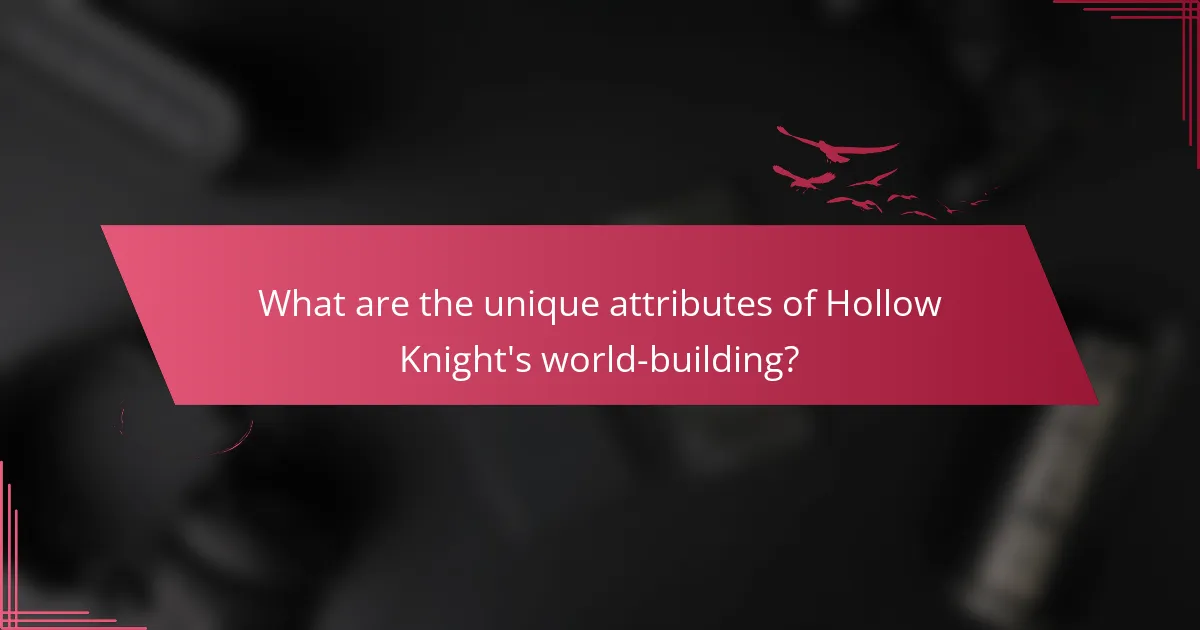
What are the unique attributes of Hollow Knight’s world-building?
Hollow Knight’s world-building features interconnected environments, rich lore, and a haunting atmosphere. The unique attributes include non-linear exploration that encourages discovery, intricate design with hidden areas, and a minimalist storytelling approach that relies on environmental cues. The distinct art style combines hand-drawn visuals with fluid animations, enhancing immersion. Additionally, the game’s use of sound design creates an emotional connection, making the world feel alive and responsive.
How do lore and storytelling intertwine with gameplay?
Lore and storytelling enhance gameplay by providing depth and context. In “Hollow Knight,” the rich narrative intertwines with exploration and combat, enriching player engagement. The game’s world-building invites players to uncover secrets, while character backstories deepen emotional connections. Artistic design complements this by visually narrating the lore, creating an immersive experience that encourages exploration. This synergy between storytelling and gameplay fosters a compelling journey through Hallownest.
What makes the character design memorable?
Memorable character design in Hollow Knight arises from its unique art style, intricate details, and emotional depth. The characters are visually distinct, with each embodying specific traits that enhance gameplay. The blend of haunting aesthetics and expressive animations creates a lasting impression. Additionally, the lore behind each character deepens player connection, making them more than mere game elements.
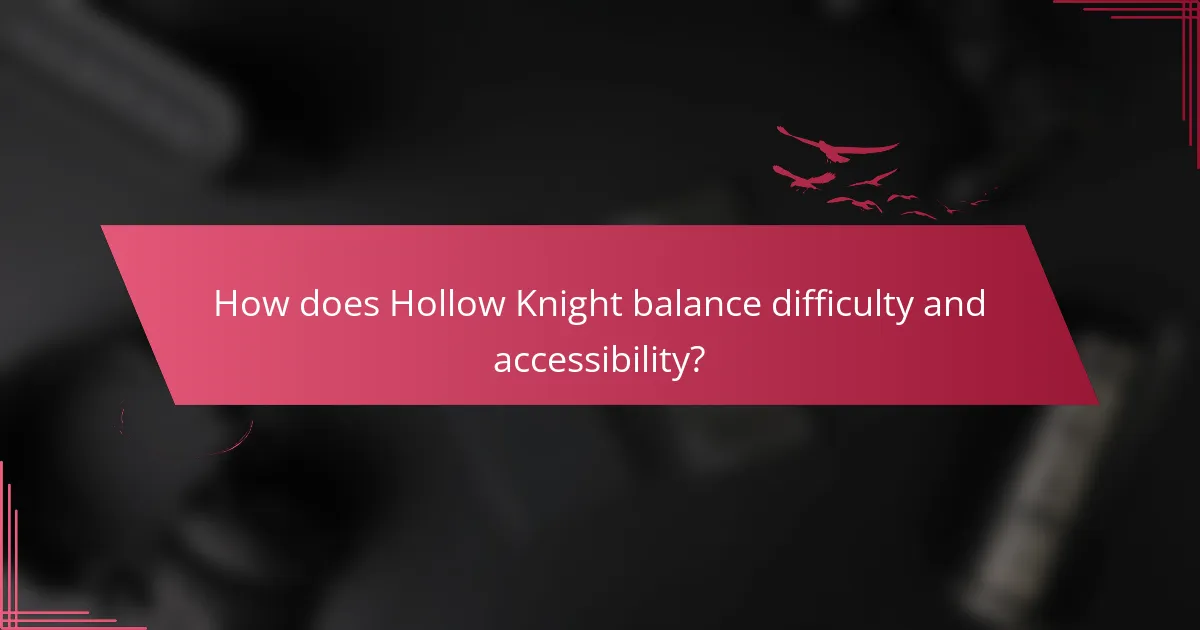
How does Hollow Knight balance difficulty and accessibility?
Hollow Knight achieves a balance between difficulty and accessibility through its design choices that cater to both casual and hardcore players. The game features a gradual learning curve, allowing players to master mechanics over time.
Combat mechanics are challenging yet fair, encouraging players to learn from their mistakes. The presence of checkpoints provides a safety net, reducing frustration during difficult segments. Additionally, players can customize their abilities, making the game more approachable.
The artistic design enhances the experience, immersing players in a visually stunning world. This aesthetic appeal draws in a wider audience, promoting exploration and engagement. Hollow Knight’s blend of challenge and accessibility ensures it resonates with diverse gaming preferences.
What strategies can players use to overcome challenging sections?
Players can overcome challenging sections in Hollow Knight by mastering movement, utilizing abilities effectively, and learning enemy patterns. Focus on precise platforming to navigate obstacles. Use abilities like the Dash or Wall Jump to reach difficult areas. Observing and memorizing enemy attack patterns allows for better dodging and countering strategies. Additionally, upgrading the character’s abilities and charms can provide significant advantages in tough encounters.
How does the game accommodate different play styles?
Hollow Knight accommodates different play styles through diverse exploration options, combat mechanics, and artistic design. Players can choose between aggressive combat or stealthy approaches, tailoring their experience. The game features various abilities and charms that enhance play styles, such as increased mobility or damage output. Additionally, the expansive world design encourages exploration, allowing players to engage with the environment at their own pace. This flexibility fosters a personalized journey, appealing to both action-oriented and methodical players.
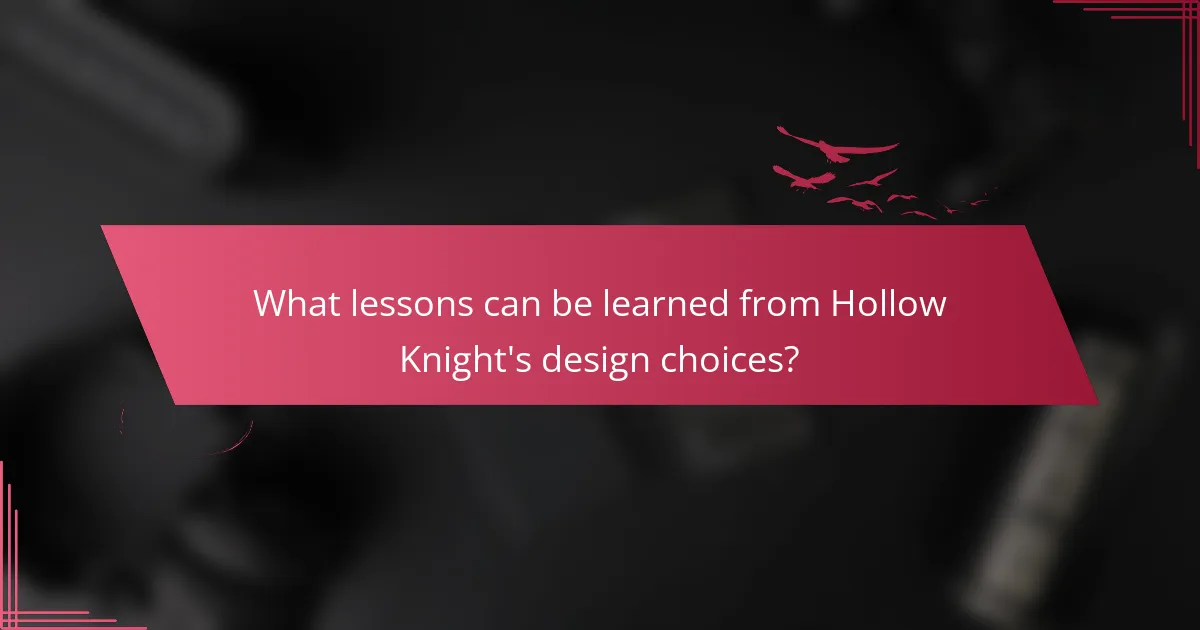
What lessons can be learned from Hollow Knight’s design choices?
Hollow Knight’s design choices emphasize exploration, fluid combat, and striking artistic visuals. The game encourages players to delve into its vast world, promoting a sense of discovery. Combat mechanics are finely tuned, allowing for diverse playstyles and strategies. The hand-drawn art style enhances immersion, creating a unique atmosphere. These elements collectively contribute to a memorable gaming experience, showcasing the importance of cohesive design in engaging players.
What best practices can developers adopt from Hollow Knight?
Developers can adopt several best practices from Hollow Knight, focusing on exploration, combat mechanics, and artistic design. Emphasizing player agency, the game encourages exploration through interconnected environments. Combat mechanics are refined, promoting skill and strategy over brute force. The artistic design creates an immersive atmosphere, blending visuals and sound to enhance player experience. These elements collectively foster a deep, engaging gameplay loop that rewards discovery and mastery.
Which common mistakes should players avoid in Hollow Knight?
Players should avoid common mistakes like neglecting upgrades, ignoring map exploration, and mismanaging health. Upgrading abilities enhances combat effectiveness. Exploring maps reveals hidden areas and resources. Mismanaging health leads to unnecessary deaths. Each of these mistakes can hinder progress and enjoyment in Hollow Knight.

